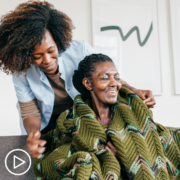Phases of AML Therapy | Understanding Treatment Options
Phases of AML Therapy | Understanding Treatment Options from Patient Empowerment Network on Vimeo.
What are the types and phases of acute myeloid leukemia (AML) treatment? Dr. Alice Mims, an AML specialist, defines induction, consolidation, and maintenance therapy for patients. Dr. Mims also explains the role of stem cell transplant and discusses promising new AML therapies.
Dr. Alice Mims is a hematologist specializing in acute and chronic myeloid conditions. Dr. Mims serves as the Acute Leukemia Clinical Research Director at The Ohio State University Comprehensive Cancer Center – James. Learn more about Dr. Mims.
Related Resources:

|

|

New and Emerging AML Therapies Being Studied in Clinical Trials |
Transcript:
Katherine Banwell:
I’d like to move on to treatment now, Dr. Mims. And, of course, treatment takes place in phases for AML. The first is induction therapy. Can you start by defining induction therapy for our audience?
Dr. Alice Mims:
Sure. So, induction therapy is really terminology that we use to talk about initial therapy for someone with a new diagnosis. So, we can have intensive induction therapies and non-intensive induction therapies. But the goal for either of those types of treatment is to get the leukemia into remission.
Katherine Banwell:
And what are the available treatment options for induction therapy?
Dr. Alice Mims:
So, to talk about that in a little bit more detail, for intensive induction regimens, those typically involve cytotoxic chemotherapy. So, you may hear terminology like, “7 + 3 induction,” or “high-dose cytarabine regimens,” but those are typically more intensive regimens that we use that can have increased side effects but may be very important based off the type of acute leukemia.
And then for non-intensive based regimens, one of the standards has really evolved to be venetoclax (Venclexta) and azacitidine (Vidaza) as a non-intensive regimen that can work very well for a majority of patients. And there are some off shoots of that as well.
Katherine Banwell:
Okay. And when does stem cell transplant come into play?
Dr. Alice Mims:
Sure. So, stem cell transplant is something that we all think about at the beginning for anyone with a new diagnosis of acute myeloid leukemia where as we’re working to get back genomic information about the individual’s acute leukemia, we may go ahead and start looking for different donors, doing typing, just in case that’s something that we need as far as someone’s therapy.
But typically we reserve stem cell transplant for patients who have either intermediate or high-risk features of their AML. Or who may have even favorable respite are not responding as well as we would like when looking at the depth of remission. And so, we always want to be prepared in case that’s something we need to move forward with as part of their care, if the goal of their treatment is for curative intent.
Katherine Banwell:
Let’s talk about what happens after the initial phase of treatment. What’s the purpose of consolidation therapy?
Dr. Alice Mims:
Sure. So, there are a few different purposes we can use consolidation therapy for. So, for patients – consolidation therapy is used for patients who have achieved remission. And then it’s either to try to hopefully get them cure of their AML. The patients have more favorable risk features of their AML and cure is an option through just chemotherapy alone.
Or it can be used to try to keep people in remission while we’re working to get towards stem cell transplant as that can sometimes take a few months to get a donor ready, have things ready to move forward with transplant.
Katherine Banwell:
And what are the options for consolidation therapy?
Dr. Alice Mims:
Sure. So, options for consolidated chemotherapy are typically based off of what you had initially for induction chemotherapy. So, if it’s more intensive-based regimens, it typically is consolidation with intensive consolidation, cytarabine-based (Cytosar-U) regimens.
For lower intensity regimens, typically consolidation is more continuing therapy on what you started but may have adjustments of the treatment based off of trying to decrease the toxicity now that the patients are in remission.
Katherine Banwell:
And how are patients monitored in consolidation therapy?
Dr. Alice Mims:
Sure. So, it definitely is based off of the individual’s type of consolidation chemotherapy or treatment. But most patients, if we feel like the treatment is going to lower blood counts, they have bloodwork twice a week, and we’re watching for things, for side effects for treatment, looking out for risk of infection, giving transfusion support, and then if something happens that we feel like we can’t support patients in an outpatient setting, then we’ll get them back into the hospital if they need to for care.
Katherine Banwell:
What side effects are you looking for?
Dr. Alice Mims:
So, most of the side effects with any of the treatments that we give are what we call myelosuppressives. So, it lowers the different types of blood counts.
So, white blood cell count which increases risk of infection, red blood cells, so, side effects or symptoms from anemia. And then risk of bleeding from low platelet counts.
Katherine Banwell:
Okay. Maintenance therapy has become more common in other blood cancers particularly in multiple myeloma. Is there a role for maintenance therapy in AML?
Dr. Alice Mims:
There actually is now, which is something that’s newer that has evolved for acute myeloma leukemia. So, in the context of intensive therapy, we now have oral azacitidine (Onureg), which is a little bit different than some of the IV formulations that we give.
But for patients who receive intensive induction therapy, get into remission and may receive consolidation but are not able to go onto transplant if they have that immediate or higher risk features, there’s FDA approval for oral azacytidine, which has been shown to improve overall survival and keep people in those remissions for longer.
More recently, specifically for patients who have a particular type of mutation called FLT3, if they also receive intensive induction therapy with a FLT3 inhibitor added onto that, then their quizartinib (Vanflyta) was just recently approved as a maintenance therapy for patients with that particular type of AML.
Katherine Banwell:
Are there emerging AML therapies that patients should know about other than what you just mentioned?
Dr. Alice Mims:
Sure. So, I think there are a lot of exciting treatments that are up and coming based off of many small molecule inhibitors that are being studied.
One in particular I would mention that everyone’s very excited about is a class of agents called menin inhibitors.
And so that’s an oral agent that has been shown to have responses for patients with relapsed or refractory AML who have NMP-1 mutations or have something called KNT2A rearrangements. And seeing responses with just a single agent in the relapsed/refractory setting, it’s been really exciting. And so, I think we’re hopeful that that may become FDA-approved in the near future. And it’s also now being explored in combination with intensive chemotherapies as well as less intensive induction regimens. And so, maybe we can do a better job with upfront treatment by adding these therapies on.










